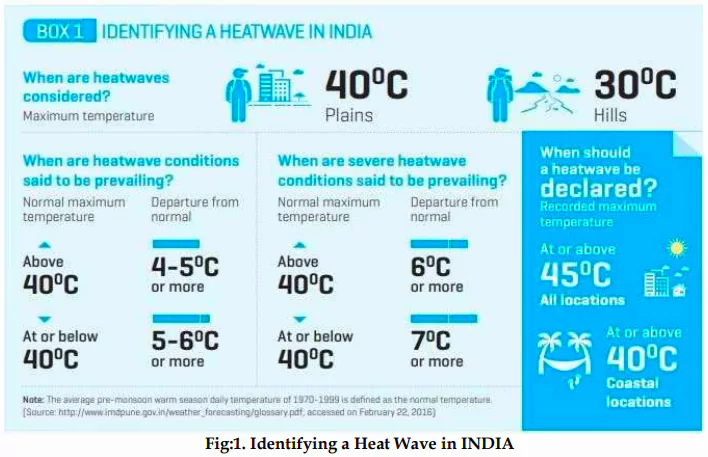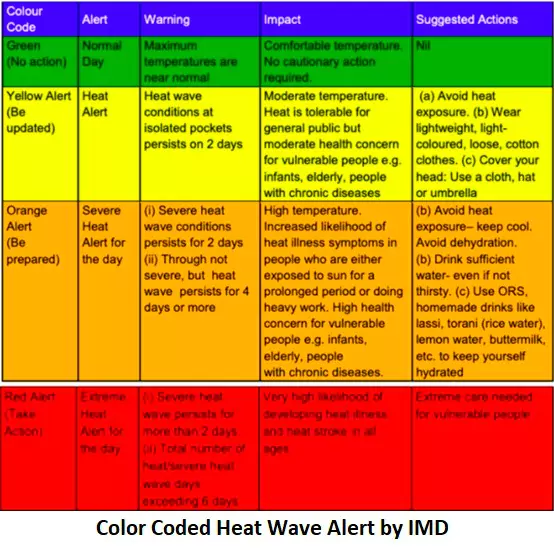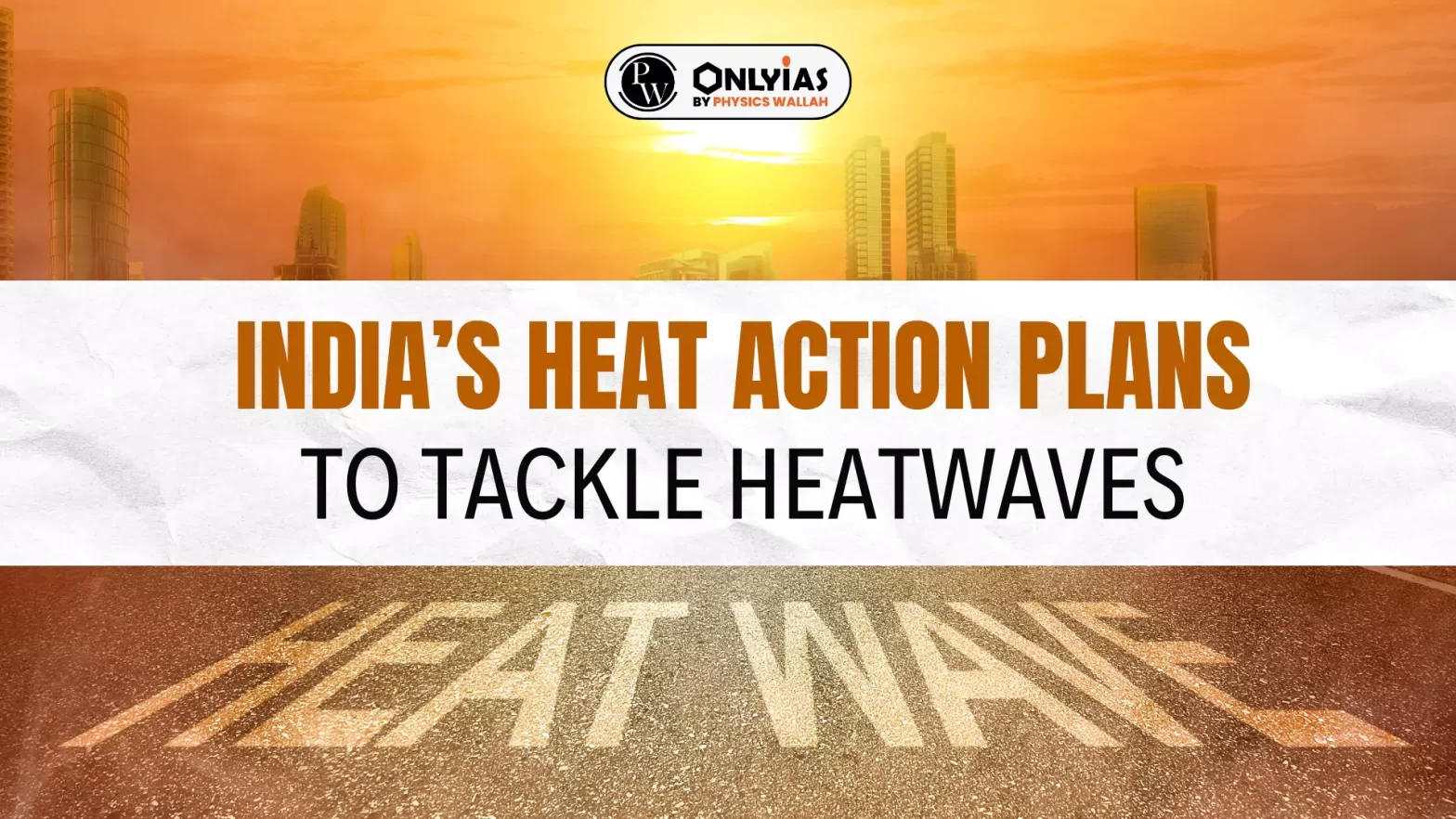Context
The Indian Meteorological Department (IMD) has issued alerts regarding heatwaves for various parts of India.
IMD Heatwaves Update
- Heatwave alerts have begun from February itself, as various parts of the northeast and western India have already reported appreciably warming even before the start of summer.
- The IMD has also predicted an increase in the maximum temperature and the frequency of heatwave conditions in the forthcoming days over eastern and southern India.

Enroll now for UPSC Online Course
About Heatwaves
- Heatwaves: Heatwaves are extended periods of excessively high temperatures that can have severe implications on human health, environment, and the economy. India being a tropical country is particularly vulnerable to heatwave conditions.
- Declaration of Heatwaves: According to IMD, the definition of a heatwave depends on the physiography of regions. Following criteria for Heat Wave declarations have been provided:
- Heat wave declaration is considered if the maximum temperature of a station reaches
- at least 40°C or more for Plains,
- 37°C or more for coastal stations and
- at least 30°C or more for Hilly regions.
- A heatwave’s severity is determined by its departure from normal temperature
- Normal Heatwave: When the departure from Normal is by 4.5-6.4 degrees Celsius and
- Severe Heatwave: When the departure from Normal is greater than 6.4 degrees Celsius
- Based on Actual Maximum Temperature (for plains only):
- Heat Wave: When actual maximum temperature 45°C
- Severe Heat Wave: When actual maximum temperature 47°C
- The IMD considers the criteria of “departure from normal temperature” and “actual maximum temperature”, only when at least two stations in a meteorological subdivision report such a high maximum or when at least one station has recorded a corresponding departure from the normal for at least two consecutive days.
Status of Heatwaves In India
- World Bank report in November warned that by 2030, over 160-200 million people across India could be exposed to lethal heat waves annually.
- The IMD forecast for hot weather has said most of India, barring parts of the east and the northeast and some pockets in the northwest, will experience above-normal maximum and minimum temperatures.
Causes of Heatwaves
- Global Warming: It has led to an average increase in temperature of 0.8 degrees Celsius over the past century, exacerbating the frequency and intensity of heatwaves.
Humid Heatwave:
- The basic criteria for IMD to declare a heatwave currently does not include taking into account relative humidity, which is increasingly becoming a cause of humid heat waves.
- During a humid heatwave, the temperature felt by the human body or by other animals and plants is much higher.
|
- Urban Heat Island Effect: Urban areas, with their dense construction and concrete surfaces, retain more heat than rural areas, amplifying local temperatures during heatwaves.
- Reduction of frequency of Pre-Monsoon Showers: The period leading up to the monsoon season usually sees some rainfall, which helps to moderate temperatures. However, reduced rainfall before the monsoon season leaves the ground dry, increasing local temperatures and setting the stage for heatwaves.
- El Niño Effect: It is a climatic event characterized by the warming of the central and eastern tropical Pacific Ocean and altered wind patterns, which can reduce monsoon rainfall in India and contribute to hotter conditions.
- High Atmospheric Pressure Systems: It can lock heat close to the ground by preventing hot air from rising and dispersing. This prevents heat dissipation through cloud formation and rain, leading to increased surface temperatures.
- Urbanization: Unplanned expansion of urban spaces accentuates the heat island effect, as natural landscapes that cool the environment are replaced with heat-retaining materials like asphalt and concrete.
Government Initiative Regarding Heatwaves
- Climate Hazards and Vulnerability Atlas of India: The atlas provides a range of vulnerability with risks ranging from nil, low, moderate, high and very high categories for every Indian district with regards to major weather events.
- India’s Cooling Action Plan: It provides a long-term vision to address the cooling requirement of various sectors.
- Model Heat Action Plan: It has been released by the National Disaster Management Authority (NDMA) to provide hyperlocal warning systems, vulnerability mapping of cities, and climate-resilient housing policies.
|
Enroll now for UPSC Online Classes
Impacts of Heatwaves
- Health Impact: Heatwaves dramatically hinder the body’s temperature regulation, leading to severe health issues like heat cramps, heat exhaustion, heatstroke, and hyperthermia.
- A 2019 analysis from the Tata Centre for Development and the University of Chicago predicts that by 2100, more than 1.5 million people per year may pass away from heat-related deaths brought on by climate change.
- Water Stress: Heatwaves intensify water scarcity by drying up reservoirs and reducing water availability for agriculture and domestic use. This scarcity can lead to conflicts over water resources, affect irrigation practices, and impact industries that depend on water.
- Increased Energy Demands: The demand for electricity surges as people seek cooling solutions, straining power grids and increasing the risk of blackouts. This disrupts economic activities and affects the vulnerable populations the most.
- Economic Impacts: Heatwaves reduce the number of workable days, impacting the livelihoods of farmers and daily wage workers. It also decreases agricultural yields, as witnessed in significant losses in wheat production in states like Haryana, Punjab, and Uttar Pradesh.
 Impact on Livestock: Increased temperatures lead to heat stress in livestock, significantly reducing productivity such as milk output in dairy farming.
Impact on Livestock: Increased temperatures lead to heat stress in livestock, significantly reducing productivity such as milk output in dairy farming.-
- According to Cornell Researchers, milk outputs in India’s arid and semi-arid dairy regions are expected to drop by 25% by 2100 compared to 2005 levels.
- Impact on Food Security: Heat and resulting drought conditions lead to crop losses which result in food insecurity. These conditions are expected to raise food prices, lower incomes, and increase rates of malnutrition and climate-related mortality.
- Impact on Workers: Workers in sectors like agriculture and construction face increased risks from heatwaves. These impacts are exacerbated for the poorer sections due to increased vulnerability.
- The International Labour Organisation estimates that working hours lost due to heat stress would increase to 5.8 percent of working hours by 2030, or an equivalent of 34 million jobs.
- Heat Dome: It is a type of high-pressure system that forms over a large area in the atmosphere, and causes extremely hot and dry weather conditions. The system traps hot air and prevents it from flowing to rise and cool.
Heat Action Plans to Tackle Heatwaves
- Background: Heat Action Plans (HAP) was first developed in the country in 2010, by Ahmedabad’s municipality in partnership with the Indian Institute of Public Health and American academies, in response to more than 800 deaths in the city due to heat waves.
- About: Heat Action Plans (HAPs) are India’s primary policy response to economically damaging and life threatening heat waves.
- Objective: It aims to decrease the impact of heatwaves and prescribes a variety of preparatory activities, disaster responses, and post-heatwave response measures across state, district, and city government departments.
- Focus: It focuses on creating an early warning system, increasing the capacity of healthcare professionals and promoting adaptive measures in workplaces and creating awareness
- Current Status: The National Disaster Management Authority and IMD are working with 23 States to develop HAPs.
- There is no centralized database on HAPs, but at least 23 HAPs exist at the State and city level, with a few States, such as Odisha and Maharashtra, laying out district-level HAPs.
-
Components of Heat Action Plans:
-
- Regional Heat Profile: It provides an overview of the region’s climatic conditions by documenting past heatwave occurrences, trends in summer maximum temperatures, and land surface temperatures.
- Vulnerability Assessment: It also maps out regions requiring immediate attention, prioritizing resource allocation and targeted interventions to those most vulnerable, such as the elderly, children, and outdoor workers.
- Mitigation Recommendations: HAP provides strategies to reduce heatwave impacts, such as urban greening, water distribution improvements, and infrastructure modifications to reflect heat.
- Response Plan: HAP outlines specific actions to be taken before, during, and after a heatwave. It includes activating emergency cooling centers, distributing hydration kits, and other health safety measures to protect the population.
- Roles and Responsibilities: HAP delineates the roles for various governmental and non-governmental organizations, including the disaster management authority, health services, labor department, and police.
Recommendations of Heat Action Plans
- Forecasting and Early Warning Systems: HAPs recommend utilizing meteorological forecasts to provide early warnings to the public and authorities.
- Public Education and Awareness Campaigns: It also recommends educating the public about the risks of heatwaves through widespread information campaigns.
- Establishment of Heat Shelters and Cooling Centres: To offer immediate relief during extreme heat events, HAPs suggest setting up dedicated heat shelters and cooling centers.
- Access to Clean Drinking Water: HAPs suggest installation of water dispensers in public areas and the distribution of water bottles during high-temperature periods.
- Healthcare System Preparedness: HAPs recommend hospitals to be equipped with essential supplies and well-trained healthcare workers, to handle the surge in patients suffering from heat-related illnesses effectively.
- Sustainable Urbanization Practices: HAPs also suggest long-term measures such as adopting urban planning strategies that promote tree planting, using heat-resistant building materials to reduce urban heat island effect, and using cool roofing technologies to reduce solar absorption, thereby decreasing indoor temperatures.
- Coordinated Response Efforts: HAPs push for effective coordination among stakeholders, including government agencies, healthcare providers, community organizations, and emergency services.
Challenges of Heat Action Plans
- Local Context Limitations: Current HAPs use national thresholds to define heatwaves, which do not adequately reflect the diverse climatic, geographic, and urban conditions across regions.
- Ex. Many cities have been reeling under extreme temperatures, although no heatwave has been declared.
- Inconsistent Methods: The vulnerability assessments within HAPs are often inconsistent, leading to ineffective strategies that may not comprehensively address the actual risks.
- Vulnerable Populations: While HAPs aim to protect vulnerable groups, the interventions often do not account for the varied needs of different communities, especially in relation to local demographic and socio-economic factors.
- Centre For Policy Research’s critical review of heat action plans at the city, district and state levels across 18 states found lack of clarity about the implementation of the HAPs.
- Siloed Approach of HAPs: HAPs typically operate in isolation with limited financial support resulting in reduced effectiveness of the measures.
- Inadequate Legal Foundations: Most of the HAPs lack a robust legal authority, which undermines their implementation and compliance. Additionally, there is no consistent mechanism for updating HAPs based on new data or successful outcomes.
- Lack of Focused Planning: While HAPs mention long-term measures, they are limited to building infrastructure (especially cool roofs), with a cursory mention of green and blue spaces.
- Resource Allocation: The success of HAPs can vary widely based on local government priorities and available resources. There is a crucial need for dedicated funding and collaborative financial planning to support comprehensive heat action.
Enroll now for UPSC Online Course
Way Forward to Mitigate Heatwaves Risk
- Comprehensive Climate Risk Assessments: There is a need to develop a full-fledged climate risk assessment framework that can accurately identify areas at risk of heatwaves and evaluate the exposure of people and assets.
- Development of Modified Heat Index: There is a need to create a multidimensional heat index that takes into account factors beyond temperature, such as humidity and the urban heat island effect.
- This index should reflect regional and local variations in climate, demography, and infrastructure to tailor HAPs more effectively to specific needs.
- Financial Strategization for Efficient Resource Allocation: There is a need for secure dedicated funding for the implementation of HAPs through setting up financial mechanisms in collaboration with state authorities, civil society organizations, and worker unions.
- Integration with Urban Planning and Resilience: Link HAPs with broader urban resilience and climate adaptation strategies to pool resources more effectively.
- Incorporation of Nature-Based Solutions: There is a need to focus on integrating nature-based solutions such as strategic placement of green spaces and the development of blue infrastructure into HAPs to mitigate the impacts of extreme heat.
- Accountability and Transparency: Create an online national repository of HAPs that is regularly updated and tailored to regional needs to improve transparency and accountability in heatwave management.
Also Read: Changing Rainfall Patterns In India’s Sub-Districts
To get PDF version, Please click on "Print PDF" button.


 Impact on Livestock: Increased temperatures lead to heat stress in livestock, significantly reducing productivity such as milk output in dairy farming.
Impact on Livestock: Increased temperatures lead to heat stress in livestock, significantly reducing productivity such as milk output in dairy farming.